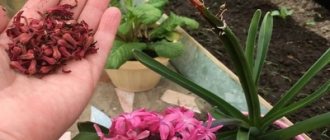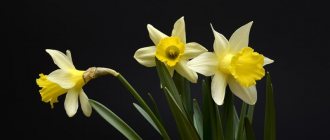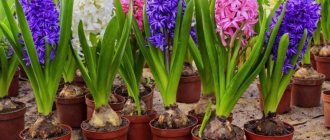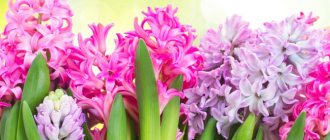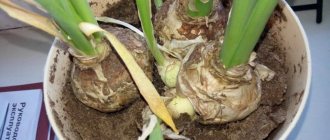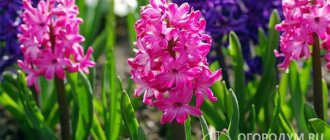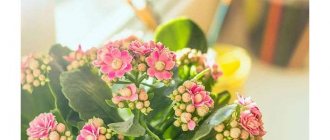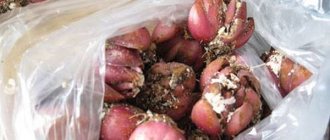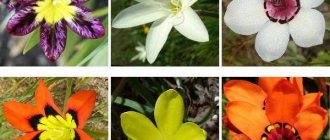Growing hyacinth is not a problem. It is much more difficult to achieve flowering by the desired date. We'll tell you how to make hyacinths bloom for the New Year, Valentine's Day or March 8th.
Hyacinth bulbs are used not only for planting in open ground, but also for forcing at home for the New Year, Valentine's Day and March 8th. Of course, you can not complicate your life and just buy your favorite flower in a pot on the eve of the holiday. But in fact, the process itself is quite simple. In addition, self-grown flowers will be cheaper. And the joy of seeing tender buds bloom cannot be compared with anything!
Hyacinths are easy to force. Even if you make a mistake, you are unlikely to ruin the bulbs. The worst thing that will happen is that flowering will occur earlier or later than planned, and the sultan-inflorescence itself will not stretch enough.
Forcing hyacinths in water
agardenforthehouse.com
Hyacinths can be grown not only in soil, but also in water. This method allows you to get a beautiful flower even faster. However, certain rules still need to be followed.
Firstly, it concerns capacity. It is desirable that this be a special vessel. But if you don’t have one, you can use a regular tall glass.
Secondly, you should not use tap water. It is better to replace it with melted one. Pour the liquid so that, after placing it on the edges of the glass, there is 1.5-2 cm between the bottom of the onion and the water.
Also place the bulbs for forcing hyacinths in water in a cool, dark place, for example, in the refrigerator, where they will spend several months until roots appear. Then move the hyacinth to a warmer place and cover with a cap. The cap can be removed only after the sprout appears.
How to cut correctly?
Growing for cutting has some differences:
- the cold rooting time is increased by 2 weeks so that relatively long peduncles grow;
- cut off when fully bloomed;
- each inflorescence is wrapped in paper and carefully stored in a cardboard box at 2oC;
- It is allowed to cut with colored but unopened buds, which are placed in water at room temperature overnight before use;
- cutting with part of the onion improves preservation during transportation.
Chemical additives – Zircon, Vitalizer – will extend the life of the bouquet. Cut hyacinths love coolness, adequate lighting, and fresh water at room temperature.
Resuscitation of hyacinth bulbs after forcing
gardeningknowhow.com
Forcing greatly depletes the bulb. Therefore, after the hyacinths bloom, many people prefer to simply throw away the used planting material. But if you put in a little effort, the bulbs can be revived. To do this, follow our recommendations.
- Remove dried inflorescences.
- Fertilize the hyacinth once with fertilizer for bulbous plants.
- Raise the air temperature to 22-23°C and continue to light the flower and water it moderately for a week. This is necessary to activate the process of regeneration bud formation.
- After a week, reduce watering and leave only natural light.
- Stop watering completely when the leaves begin to yellow.
- Place the pots on their side to ensure better flow of nutrients from the green mass to the bulb.
- Remove the bulb from the soil after the leaves have completely died. Dry it and store it at 17°C until planting.
The largest bulbs can be used for re-forcing. But be prepared for the fact that the flowering will no longer be so lush. It is better to plant the hyacinth in the ground so that it can fully regain its strength.
Forcing hyacinths is one of those activities that, once you try it, you can’t stop. After all, their delicate or, on the contrary, bright inflorescences are a real spring miracle, which is so missed during the long winter months.
Watering and fertilizing
In winter and spring, you need to carefully ensure that the substrate does not dry out during forcing, otherwise the growing roots will lift the bulb and roll it to one side. Therefore, watering is needed regularly and in small portions. When the plant enters the dormant stage, it is practically reduced to a minimum. A wilted plant is not watered at all.
Feeding hyacinth is carried out systematically. For plants whose bulbs are at the dormant stage, slightly dissolved phosphorus-potassium fertilizers are required.
During flowering, compositions are used to feed the plant, with the help of which they stimulate the plant.
Optimal varieties for the greenhouse
With a significant number of hyacinth varieties, not all types are suitable for early forcing in a greenhouse.
The ideal varieties to get flowers in late autumn and early winter are presented in the table:
| Hyacinth variety | Peculiarities |
Jan Bos | A delightful flower up to 30 cm high. Dark red flowers with a crimson tint have a strong aroma. Dense inflorescence, with more than 30 flowers, with a diameter of 35 mm, blooms for up to 20 days. |
| The flower is bright pink, pearlescent, 40 mm in diameter, with a strong aroma. The inflorescence has the appearance of a candle, consisting of small bell-shaped flowers in the amount of 25 - 40 pieces, 22 cm long. The plant reaches a height. 30 cm. |
| The flowers are pale blue-violet with a distinct band of darker color. The height of the flower arrow is 22-25 cm. It blooms for up to 14 days. |
| A cone-shaped inflorescence with bright pink flowers and a dark stripe located in narrow areas near the flower bed. Long, up to 70 mm, bracts that resemble leaves. |
| They have pearlescent inflorescences up to 20 cm long, with large flowers up to 45 mm in diameter. |
| Plants with dense wide inflorescences up to 15 cm long, blue flowers, up to 40 mm in diameter. |
| The middle flowers are purple-violet. |
| Plant height is up to 25 cm, the flowers are light pink, have a yellowish-pink tube near the flower bed, the inflorescence is loose, cylindrical in shape. |
| Peduncle up to 26 cm high, flowers up to 40 mm in diameter, perianths wide, spreading. |
For forcing medium-sized plants, the following are suitable:
| Hyacinth variety | Peculiarities |
| Medium variety, plant height up to 22 cm, cylindrical inflorescences, flower diameter up to 40 mm, with wide perianth lobes. |
| The flowers have a salmon-apricot hue, with a yellow throat and dark pink ends. Plant height up to 20 cm, with long pedicels. |
| The middle flowers are dark blue, lighter along the edges. Flower arrows up to 30 cm high. |
| Medium, soft pink, porcelain flowers, with a peduncle height of up to 22 cm. |
| Compact, wide-cylindrical inflorescences of a delicate lilac-raspberry color. Peduncles up to 25 cm high. Flowering lasts up to 7 days. |
| The flowers are bright orange, with a peduncle height of up to 28 cm. It blooms for up to 15 days. |
| The flowers are white, with a slightly yellow tint near the base. Peduncle dimensions up to 24 cm. |
Tip: When planting flower bulbs in the ground, you should avoid mixing varieties and place other flowers next to hyacinths.
Possible problems
One of the most common problems with hyacinths is a sparse ear. This feature not only worsens the appearance of the flower, but also shortens the flowering period. There are several reasons for this phenomenon:
- Young bulbs. Most often they sell planting material suitable for planting directly in open ground or for subsequent growing. Such specimens do not produce lush, abundant flowering. And plants intended for forcing have large bulbs, often 2 times larger than those intended immediately for planting in the garden.
- Re-sort. This problem often occurs when buying flowers at reduced prices, when instead of varietal bulbs, unscrupulous sellers sell species plants that have much worse characteristics.
Of course, it’s not difficult to buy flowering hyacinths in pots now, even starting in November, and in the spring there are a lot of them on sale. However, plants of truly good quality, alas, are not found too often. Much longer and more luxuriant flowering can be achieved by growing the flower yourself, having previously carried out forcing manipulations. At the same time, you should follow a number of simple rules and everything will definitely work out.
Color Mismatch
If we do not take into account the possibility of a banal re-cultivation, there are other reasons why a flowering plant may not correspond to the bright picture on the packaging. The main reason for flowers that are more faded than expected is lack of lighting.
Most often, hyacinths are driven out without any additional lighting and sunlight on the windowsill may well be enough for them. However, lack of light can affect the intensity of some colors. Fortunately, this problem does not affect dark-colored varieties: lilac, crimson, purple and blue. But the shade of colors that are rarer for hyacinth can vary greatly.
In particular, hyacinth is not bright yellow even in open ground, and on the windowsill it will definitely be more of a lime color with a yellowish tint. Why then in numerous photos we see hyacinths that are richly yellow, like chickens, we can only guess. Either they don’t have enough light in temperate latitudes, or are these all “miracles” of photo editors?
In any case, having tried all the available varieties of yellow hyacinths in my garden and on the windowsill, I can say that absolutely all of them turned out to be very, very pale. The situation is similar with orange hyacinths. At best, the orange varieties gave me pale salmon-colored petals, and often they had pinkish hues without a hint of orange. Therefore, I am afraid that the rich orange hyacinths, the color of a ripe apricot, exist only in a picture. And another common hoax is red hyacinth. In reality, red varieties turn out bright pink.
Having tried all the available varieties of yellow hyacinths, I can say that absolutely all of them turned out very, very pale. © Lyudmila Svetlitskaya
Peduncles are too elongated or excessively short
When forcing hyacinths, their flower stalks often grow too long, bend under the weight of the inflorescences and require garter. This greatly spoils their appearance. In another case, we observe “dwarf” hyacinths, when the arrow does not extend at all, and the flowers begin to bloom, being squeezed by foliage that has not even really grown back. These two seemingly completely opposite problems have common roots.
After the end of the cold rooting period, when you transfer hyacinths to heat, it is very important to observe certain conditions. It is best to get hyacinths when the bulbs have “spouts” of at least 3-4 centimeters, and not just when they have begun to sprout. Logically, you immediately want to place the plants on a sunny windowsill. You can't do that! This is what most often provokes underdevelopment of the peduncle with premature blooming of flowers inside the foliage.
At first, it is recommended to keep hyacinths in shade for about a week so that the flower arrow stretches upward. At the same time, the temperature regime is no less important. If hyacinths stand in the shade in a hot room, we will get elongated, lodging flower stalks. The optimal temperature at this time is +16…+18 degrees. And only when the shoots actively begin to grow and reach a height of about 10 centimeters, they can be exposed to light and kept at normal room temperature above 20 degrees.
However, problems with flower stalks sometimes occur for other reasons. In particular, an underdeveloped shortened peduncle may also be a consequence of an insufficient period of cold rooting (less than 2.5 months) or this can be caused by poor watering. If the peduncles are too elongated, in order to avoid their lodging, feed the hyacinths with a 0.2% solution of calcium nitrate.
When forcing hyacinths, their flower stalks often grow too long, bend under the weight of the inflorescences and require garter. © Lyudmila Svetlitskaya

